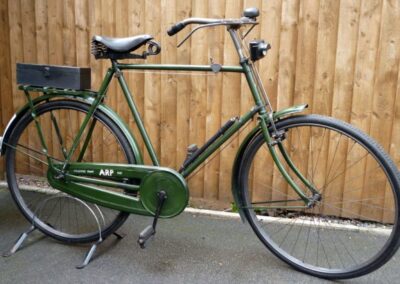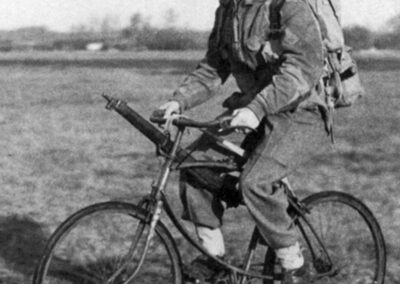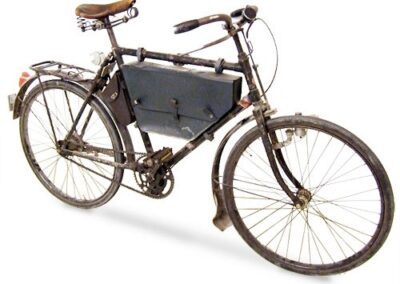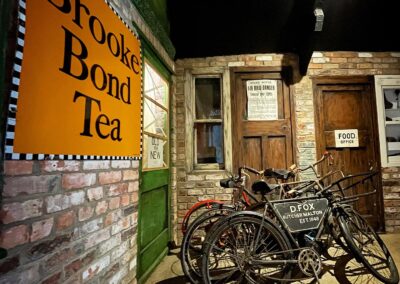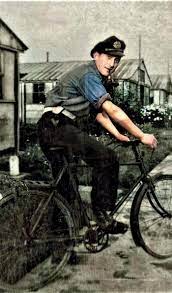BICYCLES AT WAR
Hut 11 – The All-Black Golden Sunbeam Ladies Bicycle ( Design R1)
This is an example of a Golden Sunbeam which was one of the most expensive ladies’ bicycles manufactured during the early 20th century. The bike was designed and produced by the British manufacturer, John Marston Limited of Wolverhampton between 1912 until 1956. John Marston was an extremely successful businessman who established one of the country’s largest manufacturers of bicycles, motorcycles, and cars, known for their exceptional quality. This bike was the highest specification with three speeds, leather saddle, and cost 24 Guineas when purchased in 1915. The bike was finished in black enamel and was lined with real gold leaf which added a luxurious feel.
The Sunbeam at Eden Camp originally belonged to Mary Margaret Flint (known as Margaret) who lived in Pontefract with her family. The bike was bought for Margaret in 1915 when she was at Pontefract High School. Once she completed her studies, Margaret used the Sunbeam to cycle to work, chapel and to go on bike rides in the countryside. After settling down and starting a family of her own, her daughter used the bicycle for a period before it was stored in the chicken run in the garden. It was from here that Robert Jenkinson (Margaret’s son) rescued it and with the help of Eden Camp, restored the bike with conservation as the main priority.
Conservation work was undertaken with the aim of pausing the Sunbeam in time. This meant that no new paint was added, as well as no modern-day parts being used. The work that was carried out could be reversed if necessary. For example, the leather seat has been treated with leather oil, the skirt guard (on the back wheel) has been restrung, and the frame has been treated with a conditioner. Eden Camp was also able to replace the service packs from the handle bars, a mudguard yoke and a wire wheel under the saddle with period-type examples of these, restoring the bike to its authentic state, without losing its character.
The History…
Bicycles were a very popular and well-used form of transport during the war for both civilians and military personnel. The bicycle provided a faster means of getting from A to B than walking, whilst they were cheaper and more readily available than motor cars. Those civilians that had motor vehicles were severely restricted from using them as a result of the rationing of fuel. Private vehicles were also often commandeered for military use. Bicycles provided the main form of transportation for the civilian population, not only in Britain but also in many of the occupied countries of Europe.
The Military also used Bicycles, for they allowed a soldier to move much faster over flat ground than he could on foot. They were also easy to manufacture, maintain and transport, and would work in most weather conditions. Although not used much on the front lines, they were used by reserve troops to be able to respond quickly to an advance or attack. British soldiers of the Black Watch garrisoned on the Isle of Wight were provided with bicycles in case the Germans continued their attack after Dunkirk. Support troops such as despatch riders also used bicycles 9and motorbikes). Air force personnel (Fighter Pilots and Ground Crew) often used bicycles to quickly get themselves to their aircraft when the Scramble was sounded. The Japanese employed the bicycle more successfully than any other army during their advance through Asia and the Pacific.
The Prisoners of War here at Eden Camp used bicycles to get themselves to the farms on which they worked, which in some cases were up to 15 miles away. Former Eden Camp PoW Helmut Mildner worked as a bicycle mechanic during his time here, maintaining the other PoWs bikes.
Civil Defence Messengers used bicycles to convey messages from incident scenes to the control centres when telephone lines were down (See Hut 21). In the same way, Resistance fighters in Europe often used bicycles, hiding the messages inside the bike frame etc. in case they were stopped and searched by the Germans (see St. Girons display in Hut 9).
The Folding Bike
The folding bike that is positioned on the extreme right of the cycle shed was designed by William Henry Taylor in the early 1940’s when he was Works Manager of B.S.A. Cycles, Birmingham. For the design he received a £100 Christmas bonus. The bike was used extensively by British Forces all over the world, and it was favoured by airborne forces because of its light and compact design. After the war, William Taylor adapted his design and created a generation of children’s bikes known collectively as Fairy Cycles.

